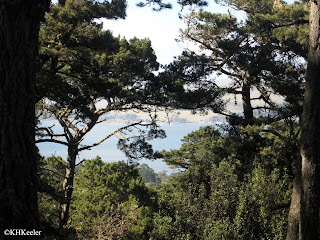 |
| Forest, California coast |
 |
| Tomales Bay, California |
Not far from the coast, the penninsula with Point Reyes National Seashore has forest to ramble through. Trees included some coast redwoods, but also Douglas fir (Pseudotsuga menziesii), big leaf maples (Acer macrophyllum) and California bay (Umbellularia californica).

I don't have decent pictures of the trees because I haven't practiced tree portraits: you have to stand back to capture the tree's shape and take some close ups of leaves and fruit.

I don't have decent pictures of the trees because I haven't practiced tree portraits: you have to stand back to capture the tree's shape and take some close ups of leaves and fruit.
From the top of the trail we could see north and west to Tomales Bay. The trail continued on to the beach, but we didn't go that far.
 |
| incoming fog |
As the fog started to roll in in the afternoon, I worried that it would be difficult to find my way back to the hotel in thick fog. But that didn’t happen. Light fog just shifted the light, making mysterious views.
 |
| star flower Trientalis europaea (primrose family, Primulaceae) |
It was May and there were all kinds of interesting spring wildflowers along the trail. This lovely plant is star flower:
 |
| Rubus ursinus, Pacific dewberry rose family, Rosaceae |
Spiny, viney berry plants draped the vegetation. My closeup doesn't reflect the long shoots of the plant, which is probably the Pacific dewberry, also called the California blackberry Rubus ursinus. Formerly called R. vitifolius (rose family, Rosaceae) the Pacific dewberry is a blackberry relative. Or I might better say, it's one of the blackberries. The edible fruits, which you can find throughout the forest later in the year, look and taste like commercial blackberries. Or taste better, since they were found along the trail during a hike. Coastal northern California has a number of Rubus species with edible fruits, including thimbleberry, Rubus parviflorus, salmon berry, Rubus spectabilis, and introduced and widespread Himalayan blackberries, Rubus armeniacus.
We heard birds in the trees above us but didn’t see wildlife...except for this banana slug which was crossing the path. Banana slugs are big and conspicuous shell-less snails. Slimy and so rather repulsive. Often they are a much brighter yellow than the one I photographed. They feed on the litter of the forest floor and so make an important contribution to forest recycling. They are interesting distinctive animals, tho not very cuddly (more about banana slugs)
The banana slug is the mascot of the University of California, Santa Cruz, a choice that, after 30 years, I remain both amused and horrified by. (see story)
 |
| banana slug |
Comments and corrections welcome.
Kathy Keeler, A Wandering Botanist
More at awanderingbotanist.com
Join me on Facebook


We heard birds in the trees above us but didn’t see wildlife...except for this banana slug which was crossing the path.berry plants
ReplyDelete